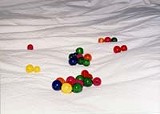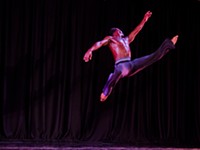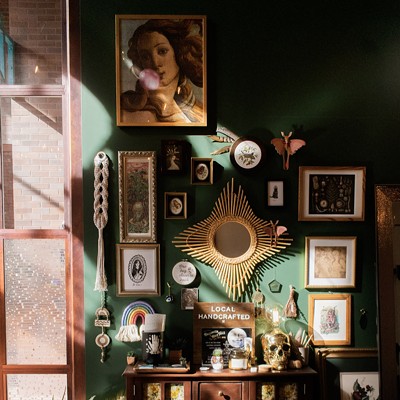[
{
"name": "500x250 Ad",
"insertPoint": "5",
"component": "15667920",
"parentWrapperClass": "",
"requiredCountToDisplay": "1"
}
]
Once upon a time, there were two Greek painters, Parrhasius and Zeuxis.
Zeuxis was considered the greatest painter of still life in the ancient world. In a competition between the two artists, Zeuxis chose to paint an arrangement of grapes and placed the painting outside. It was so realistic that birds flew down to peck at them.
Parrhasius secretly painted a curtain over his own picture of grapes. When Zeuxis entered the studio and tried to remove the curtain, he realized the curtain was painted. He also realized that he had just lost the competition: one artist fooled the birds while the other fooled the artist.
In the middle of the space of the All-Purpose Room, a short white curtain hangs from a rod suspended from the ceiling. There is no doubt that the curtain is an object rather than a picture. It recalls an early 19th-century painting, After the Bath, where a large white sheet hangs from a rope. Peeking out above the sheet is a woman's arm holding her hair and from below is her foot. We are seduced and titillated by what is not really there.
But there isn't really anything "behind" the curtain in the All-Purpose Room. Still, there's a feeling that something is supposed to be hidden. Floating in the middle of the room, the curtain implies a seduction yet to take place --- but of what or whom? Actually, this is not a curtain at all, but several restaurant tablecloths pinned together and draped over a suspended rod.
Upon closer examination, there are quilting pins randomly stuck into the fabric. In some places, folds appear, and the pinned-back corners seem to imply that something should be revealed. But what is revealed is exactly that which is not there. And since there is nothing behind the curtain, we are left only with the questions and inventions of our own mind.
In a way, all the work in this exhibition gives the impression it's a puzzle the viewer must decipher. Actually, it may be that ambiguity is the object and subject. We can't really get a fix on how or why these objects are where they are, neither can we make any concrete sense of what they mean.
For example, facing the windows are two hanging panels. One panel is made of stretched black velvet in which a small rectangular peephole allows a limited view of a glass bowl filled with multicolored wooden beads. The other panel consists of two sheets of glass. Between the sheets of glass are hundreds of wooden beads and gumballs. It's a peep show of unstrung beads and (eye) candy without any body. And then there are the titles of two other works, You Can Suck, But Don't Bite and Untitled (Play With My Balls), which, of course, are meant to be double entendres. I'm not sure what's more interesting: the suggestive interpretation or the one that's quite literal.
Also included in the installation are three photographs. One is a large, slightly out-of-focus snapshot of the colored beads on the comforter framed by a handsome black frame. Two cinderblock pilasters projecting from the gallery wall serve as a kind of secondary framing device. There is an air of importance in the way this photograph is isolated and how it commands so much space. But what's up with all these beads? What can they tell us? Can they talk? Should we even expect them to? Beads, and for that matter, photographs, are really pretty silent. We're the ones who do all the talking.
The other two photographs seem to be related to each other, as both are images of glass bowls --- one containing colored beads or gumballs and the other multicolored quilting pins --- and have simple, elegant black frames. The look is almost funerary, like those old newspaper obituaries that were framed by a fine black line. Even the lighting used is reminiscent of an official portrait or still-life painting. It's as if those objects --- the beads, gumballs, and pins --- were the artist's dearly departed, remembered only by the photographs. They are, in fact, images of objects from the artist's previous exhibit.
And then there is the sound. It's something that confronts you before you enter the space, while you're walking up the stairs to the gallery. Clink, clank, roll --- a gutter ball at a bowling alley or maybe train cars attaching and detaching at the train yard. You really can't tell what the sounds are.
Of course, it could be the amplified sound of rolling gumballs or beads. The sound is quite masterfully put together. Sometimes it's right there with you, loud and upfront, almost distracting. At other times, it seems to go away, remaining somewhere at an almost unconscious level, and then --- boom! --- it's back.
This is the work of Rochester's Scott Laird with sound by Joe Tunis. It's also Laird's second exhibition as an artist, and his first solo show. What's particularly interesting about this exhibition, aside from showcasing a new alternative venue in town, is that Laird is quite new to object making. Or rather, I should say, it is only recently that Laird thinks what he makes is art.
It may seem problematic to review an artist who just became one, but this installation is really quite successful. That's not to say there aren't some rough spots. The peephole in the velvet panel has some tattered loose ends. There's also some residual glue on the velvet that was apparently hard to remove. And there's a little dirt on those otherwise pristine (but wrinkled) white tablecloths. He really should clean-up that part of his act. Yet, all of this can be forgiven, not because Laird is new at this, but because the exhibition works despite its unevenness.
Throughout the installation, there seems to be something inviting, familiar, and definitely playful. This is especially true if you come without the expectation of seeing "Art." There is also an air of the hidden and forbidden, and because of that, the installation may seem elitist. But that has to do more with us --- the viewer, and our expectations --- than it does with Laird and his work.
Everything has been carefully laid out. Laird was and is someone who has put together numerous shows of work done by others. He is, also, quite aware of the New York City art scene. In that sense, he's been working with art objects for quite some time. Indeed, what is an artist if not a manipulator of material objects? Beyond the occasional reverent nod to artists Laird admires --- Louise Lawler, Marcel Duchamp, Felix Gonzalez-Torres, Cy Twombly, among others --- lies Laird himself, an artist in the process of becoming. Is there any other kind?
Balls and Pins by Scott Laird with sound by Joe Tunis, is on display through Saturday, February 7, at the All-Purpose Room, 8 Public Market, 2nd floor. Hours: Tuesdays and Thursdays, 7 to 10 p.m.; Saturdays 11 a.m. to 2 p.m. and 7 to 10 p.m.; or by appointment. There will be a closing reception Saturday, February 7, from 7-9 p.m. Info: 317-7461, [email protected], www.allpurposeroom.org, or www.carbonrecords.com.
Speaking of...
-
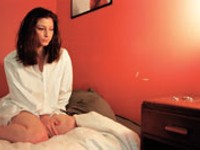
There's got to be more to it
Sep 7, 2005 -

A feast for the senses
Jun 9, 2004 -
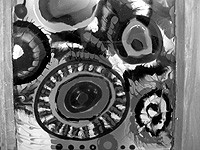
Digital cubism
Oct 8, 2003 - More »
Latest in Art
More by Alex Miokovic
-
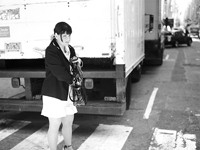
Larry Merrill at M. Early Gallery
Dec 6, 2006 -
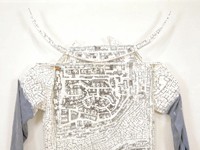
"Kim Jones: A Retrospective"
Nov 29, 2006 -
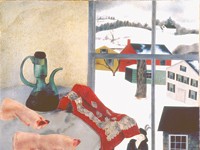
"My America" at the MAG
Nov 8, 2006 - More »
More by Heidi Nickisher
-

Larry Merrill at M. Early Gallery
Dec 6, 2006 -

"Kim Jones: A Retrospective"
Nov 29, 2006 -

"My America" at the MAG
Nov 8, 2006 - More »
